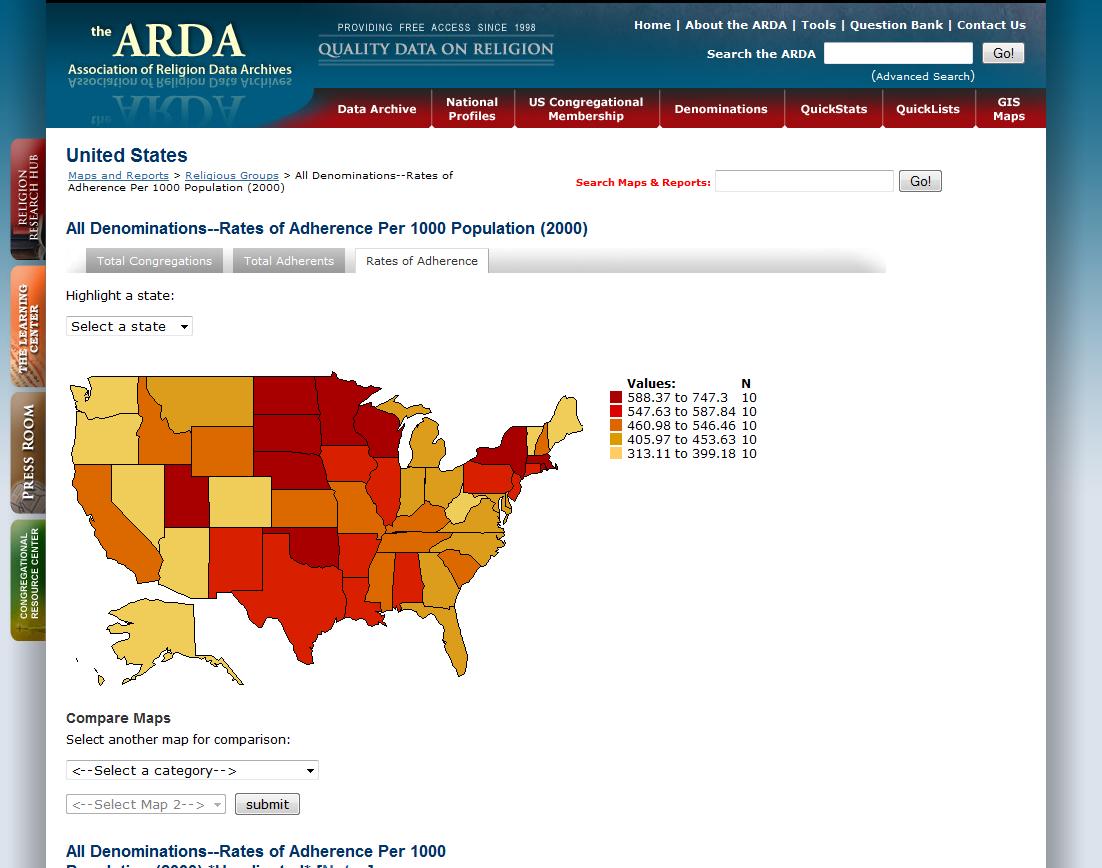
(Image Credits: Association of Religion Data Archives)
What do people mean when they say that the United States is a religious nation, or even a Christian nation? The Association of Religion Data Archives (ARDA) compiles data taken from census records and surveys to provide comprehensive information on expressions of faith throughout the nation. Of particular interest to this blog is the impressive interactive map database that allows you to choose and compare data sets in order to gain specific information about rates of adherence, denominational affiliation, and demographics. I have used these in my Literature and Religion class to help students begin to think about the relationship between faith and other socio-cultural forces, such as immigration patterns and socio-economic changes in a region.

The map above shows proportional rates of religous adherence for all denominations nationwide. The darker a state is, the more religious it is. It is perhaps no suprirse that the Midwest and parts of the Deep South show the highest rates of adherence, but it is perhaps a bit counterintuitive that parts of the Northeast--New York and Massachusetts in particular--seem to be roughly on par with Mormon-dominated Utah and Oklahoma and is actually more religious than any of the states that constitute the Deep South. As you compare this map to maps that show adherence to specific denominations, a story begins to emerge.

As you can see here, Evangelical Christian affliation tends to be concentrated in the area we think of as the "Bible Belt," not exactly a surprise.

Perhaps equally unsurprising is the fact that Catholicism tends to be concentrated in the Southwest and Northeast, areas which are known for thier concentrations of Irish, Italian, and Hispanic families. This suggests that is, indeed, the high rate of Catholic affiliation that is driving the suprisingly high proportion of religious adherence in the "Godless North." In fact, proportionally, there are more Catholics per 1000 people in the Northeast than there are Evangelicals per 1000 in the South. What this data cannot tell us, however, is what adherence actually looks like. People may express a cultural or familial affiliation with the Catholic Church, for example, even if they haven't attended mass in 15 years. Religious adherence is, after all, often as much about cultural identification as it is about faith.
The database allows literally thousands of possible comparisons and allows you to examine data down to the state and county level. One can look at rates of religious adherence and compare them to demongraphic data on immigration, gender, voting trends, crime rates, proportion of men to women, urban vs. rural population concentrations, rates of new housing development, percentage of kids in private vs. public school, occupations, education levels, and how long it takes people to get to work in the morning. For example, below I took a look specifically at Texas and compared overall rates of religious adherence to the age of the population.

This is a comparison I don't quite know how to interpret. It shows rates of religious adherence becoming higher where the population is younger, when common wisdom suggests that younger generations tend to be less religious than their parents. Perhaps it is significant that the younger counties tend to also be border counties where the proportion of people who immigrated here in the last twenty years tends to be much higher. Age might simply be a correlation or it might indicate higher levels of cultural cohesiveness, where children identify with the values of their parents much more strongly.

This one, however, isn't really a surprise. The Evangelical Lutheran Church tends to be associated with higher concentrations of descendents of German and Scandinavian immigrants, and as you can see, it tends to be particularly concentrated (though the numbers are obviously statistically small) in that area between Austin and San Antonio usually associated with German heritage.
I could go on and on. If you do anything with religion, this is a great site for students to explore and play with. It is extremely user-friendly and has the potential to challenge what we think we know about religion in the United States. It also presents an excellent opportunity to talk about how we interpret data, correlation vs. causation, and statistical significance.






Recent comments
2 years 29 weeks ago
2 years 44 weeks ago
2 years 44 weeks ago
2 years 50 weeks ago
3 years 4 weeks ago
3 years 4 weeks ago
3 years 4 weeks ago
3 years 6 weeks ago
3 years 6 weeks ago
3 years 6 weeks ago